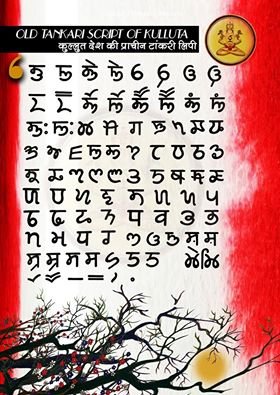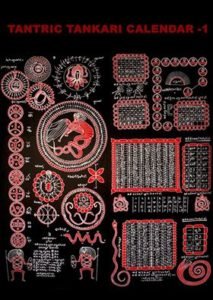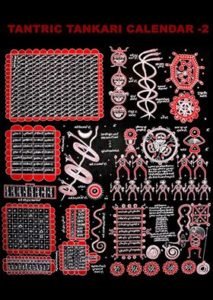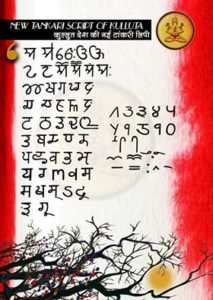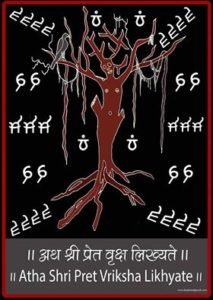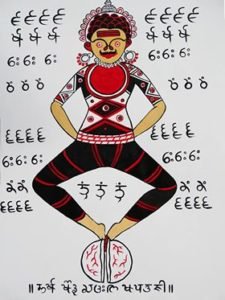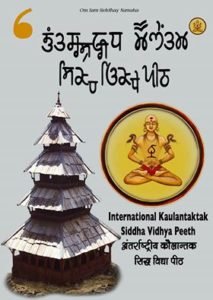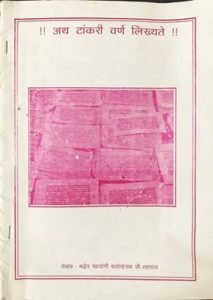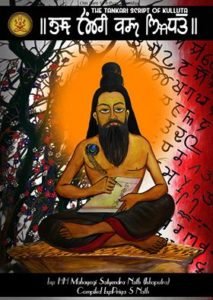Tankari Lipi is considered to be one of the oldest scripts of the world. As per Kaula Siddha Dharma, the language is considered to be the language of the folks and the common people. It is a rajasic system of script because the script was mainly used by farmers, traders, bureaucrats etc for their day to day activities. Tankari script is more democratic as it was used by both gods and demons. It was also the language of commerce back then.
The ‘Tankari Script’ is the official script of the Kaula Siddha tradition. The script has been mainly used by the whole Adi and nava 84 Siddhas to propagate the Kaula Siddha Dharma. The Tankari script is mostly prevalent and found in the region of Himachal Pradesh, India in the inscriptions of the local temples, stones etc. Just like Sarada script is believed to have originated in modern day Kashmir, the Tankari script has its origin in the hills of Kulluta mandala which is believed to be somewhere near the modern day Kullu’s Himalayan ranges.
Etymology of Tankari Lipi
The word ‘Tankari’ etymologically is derived from the word Tankar (टन्कार) and when (ई) is suffixed to the word Tankar then it becomes Tankari. Lipi means script. Tankari in short means the script of the Tankar.
As per Kaula Siddha Dharma, the word “Tankar” means the resonance created when the string of a bow is pulled and released. The vibrations thus produced are magnified by the resonance of the sound giving it the echo feel. The echo feel or the resonance of the sound is the spirit of Tankari Script.
“Tankar” also means the synthesis of two sounds, to form a new sound. It can be explained with the help of a tuning fork and a tube. When the tuning fork is stroked, it produces a sharp sound but when the sound is brought near to tube of the required length, there is some change in the sound. The new change of the sound is caused by the resonance of the sound. Resonance merely means a sound created by the cumulative reverberation of a sound. Tankar purely means resonance.
Origin and the legend of the Tankari Script
As per the Kaula Siddha Dharma, when lord Shiva created the Kaulantak Peeth for propagation of his wisdoms, the entire area were filled by gods and goddesses so as to stay cut off from the human civilization. The area thus was named as “Deva Desha” meaning the land of the gods. After considerable number of years, the “Deva Desha” was further divided into Sharda Mandala, Kulluta Mandala and other mandalas.
In the Sharda Mandala of “Deva Desha”, Lord Brahma and Ma Sarda manifested and then they both gave their script to its inhabitants, Brahmi lipi and Sharda lipi respectively. Sharda and Brahmi lipi (both Brahmi and Sharda Lipi are not to be confused with modern Brahmi and Sharda lipi) predates Tankari lipi. The Kaula Siddha Dharma says that the “Tankari Lipi” is the synthesis of Brahmi and Sharda lipi.
The lipi of the Brahma is ‘Bramhi Lipi’ and the script of the Sharda is ‘Sharda Lipi’. Both languages were very high in standards and followed strict rules of grammars. It had some phonetics sounds which were very complicated in pronunciation and could not be understood by the masses. Because of its complications, lots of rules were prescribed for writing the words in the script. A new script was very much needed to solve the ambiguity of its use.
The Rishi Munis of the Himalayas then started to perform the penances of Lord Shiva to simply the script for the convenience of the society. In the Sharda mandala, with the blessings of Lord Shiva, they asked the Goddess Sharda to simply the script and similarly in Kullata Mandala, they also asked for Ma Kurukulla to simply the script. Both the scripts were simplified by their respective goddess but the simplified versions too were very complicated. The Rishi/Munis then again simplified the scripts through their penances. The simplified scripts of Sharda lipi by the Maharishi’s were adopted by gods and then it became the official language of Sharda Mandala part of “Deva Desha” i.e. the country of the gods. The gods since after adopting the simplified script started to discriminate against the daityas and danavas. But the Kaulantak Peeth which didn’t discriminate between the gods and the danavas and daityas needed a script which could be used by everybody and was common to all.
As per the Kaula Siddha Dharma, a particular Siddha back then of Kulluta mandala or Kaulantak Peeth, worshiped and requested Ma Kurukulla to simplify the script even more and which could be used by all. Then Ma Kurukulla, stretched her bow made of the stem of lotus flowers. She stretched the thread of the bow and then released it. With the release of the string, many sounds were produced. The sound then echoed in the Hills of the Deva Desha and then resonance took place.
Just like the tuning fork and the tube, the sounds of the string resembled the sounds of the tuning fork and the reverberations of the Himalayas then known as Deva Desha served as the tube which yielded in a sound resonance. The sound thus produced were the sounds of the Sanskrit language both swara Varna (vowels) and vyanjan varna (consonants). But the resonance of those words added the phonetic sound of ‘M’ or the humming sound which is also known as anunasika sound.
The sounds thus produced from the resonance of swara varna and vyanjana varna were known as ‘Kulluka’. The ‘Kulluka’ is also known as beej mantra and from Ma Kurukulla came Kulluka. Kulluka is used in tantra to visualize and establish the sound in the crown chakra so as to unlock the mantras and yantras. This action is also called “Kulluka Sirosthapana” in agama-nigama and tantrachara.
Later, the Tankari Lipi was also used by the gods. The lipi then started to be influenced by ‘Sharda Lipi’ of the gods. The daityas and danavas then complained their Guru Maharishi Shukracharya. He then prayed Ma Vikkula and then Ma Vikkula blessed him with a new script exclusive only to danavas and daityas and the script was called “Bhoot Lipi”.
As per Kaula Siddha lineage, the modern day ‘Tankari Lipi’ was first known by ‘Tankaari Lipi’ and now as ‘Tankari Lipi’.
Characteristics of Tankari Lipi
After the inception of Tankari Lipi, the lipi became very popular with the mass. Different varieties and people of all classes, creed and sex used this lipi in their daily use. As per the Kaula Siddha Dharma, the sounds of the lipi were produced from the bow of the goddess of rajas, Ma Kurukulla, the lipi was extensively used in commerce, poetry, inscriptions, tantra, education etc. Even the Gurukula and Tantra kula’s of the Deva Desa incorporated this lipi into their teaching methodology which is still prevalent in modern day. The lipi had many characteristics which are described below:
Medium Lipi or Script
As mentioned above, the sounds produced from the bow of goddess of rajas, Ma Kurukulla this script is neither too long nor too short. Rajas way is the way of the middle path, like the rajas way, the script was also somewhere in the middle. It was neither too short, nor too long but perfectly in the middle. All together, it had 42-43 letters.
Written from left to right
The Tankari lipi is written from left to right or in the clockwise motion. The clockwise motion means the “Shristi Krama” meaning the way of creative order. The lipi originated from rajasic goddess therefore the letters are written in clockwise order from left to right and then at the end of the line, it again starts from left to right. Had the lipi been written in destructive order, it would have been written from right to left.
It is written as spoken
As per Kaula Siddha Dharma, The Tankari lipi is written as spoken with few exceptions. It is written exactly as spoken to maintain the sanctity of the spoken word. Sanskrit is a very scientific language as every word spoken has a science behind it. Every sound has its existence. No word can be denied their existence. Unlike English, Tankari lipi doesn’t have any words silent. Every spoken word is written. For instance, in the English language, the words know and now sound similar. The word known has the letter ‘k’ silent and only now is pronounced. But the pronounciation of the other word ‘now’ is not pronounced as know. Therefore, the English language has the facility of writing words not resembling the spoken words but not Tankari, if the words known and now is to be written in Tankari script, the silent letter ‘k’ will also be written and know and now will be written differently.
Resemblance of phonetics with Devanagari
The Tankari lipi’s swara varna(vowels) and vyanjana varna (consonants) resembles that of the phonetics of Devanagari. Infact, the swara varna and vyanjana varna of both are one. Only the scripts are different else everything is same including the writing order.
The half sounds
As per the Kaula Siddha Dharma, the half sounds of any word in Tankari are not written in the series of the words. The half sounds are written below the letters of the full sound. Tankari and Devanagari is also same in this aspect.
Drawbacks of Tankari
As per the Kaula Siddha Dharma, not everything of Tankari is perfect and non debatable. There are certain aspects of Tankari which can be considered as its drawbacks. Some of the drawbacks are as follows:
Drawback of ‘sirorekha’
The ‘sirorekha’ is the line that is used especially in Devanagari. It is a straight horizontal line on the top of every letters. Tankari also uses sirorekha in its script but the script is not as convenient as Devanagari. Devanagari’s sirorekha is more organized then the Tankari’s. The letters of the Tankari with the sirorekha when it comes to the proximity of another Tankari word gives a different shape and it begets confusion.
Secondly, in Devanagari all the letters of the word is connected by sirorekha but only some of the letters of Tankari uses sirorekha. Therefore in Devanagari lipi, a written word has its entire letters connected with one sirorekha but in Tankari, it is subjected to the individual letters.
Dwirupa Varna
The dwirupa varna means a letter which is formed by the amalgamation of two letters either to mean something different than the previous words or to form a third letter of vyanjana varna. The letter then formed in Devanagari is written in a new style but in Tankari, all the individual letters are written. For instance, प्र, त्र, क्ष are dwirupa varna words. In Devanagari, they are written differently than their base words but in Tankari individual letters are written.
Absence of the use of ‘Chandra Bindu’
As per the Tankari script of the Kaula Siddha Dharma, there is no provision of using the ‘chandra bindu’ in any word. For instance, the word Chandra or moon is written as चँद्र, the word has a nasal pronunciation and absence of humming. Devanagari strictly uses the chandra bindu but it is not compulsory in Tankari. The chandra bindu is used as per the discretion of the writer or the Siddhas.
Similarity of certain words
Some words in Tankari are similar in their writing. The letters of Devanagari are clear and precise but some of the letters of Tankari resembles each other. For instance, the word ‘त’ and ‘भ’ quite resembles each other in Tankari. Unless a person is highly adept in Tankari, the novice Tankari user has to interpret the letters in the words based on their own intellect and discretion which is a drawback in itself.
The irony of the swara varna in (इ)
As per the Kaula Siddha Dharma, Tankari writes a word as spoken. But it does have an exception, the exception of the writing of (इ) in any word. Normally, Tankari writes the word as spoken and not even missing any phonetics or swara but in the words starting or prefixed or suffixed with (इ), the vyanjana varna is written first and then the prefixed vowels later. For instance, in the word ‘मन्दिर’, the (इ) is written before the vyanjana varna (द) but in spoken word, the vyanjana varna comes before swara varna. It is the irony of the use of swara varna in some instances.
Many ways to write a same letter
As per the Kaula Siddha Dharma, the Tankari has different ways to write a same letter. It is because the words are written as per their class or order. Some letters when written for gods has one particular shape but if it is written for the daityas, danavas and inferiors, the other form is written. Because this script was common to both, therefore both gods and the danavas had their own ways of writing the same letter. For instance, the word ‘क’ can be written in two ways based on the circumstances in which it is written.
Kaula Siddha Dharma and future of Tankari Lipi
As per the belief of the Kaula Siddha Dharma, Tankari lipi will always exist parallel to the Kaula Siddha Dharma. The Kaula Siddha Dharma is a tantric lineage which uses mantra, yantra, tantra, yoga etc to fulfill its purpose and uses Tankari language as the official language for the inscription and description of the various aspects of Kaula Siddha Dharma.
After His Holiness Mahasiddha Ishaputra became the head of the Kaulantak Peeth and “Deva Desha”, he came to the society and witnessed the rise of use of Sanskrit language and the decline of the use of Tankari script. Sanskrit is a systematic, beautiful language that truly can only be known by the gods themselves. His Holiness harbors no ill feelings towards Sanskrit language but to revive the Tankari script of the Himalaya and also to revive the Guru-Disciple tradition based on Tankari language, he passed a circular that the Tankari script should be preserved and promoted by the state of Himachal because the script reflects the spirit of the masses. To preserve his tradition, he also took a step further by propagating the Tankari lipi through every means. The only book in the world about Tankari is also authored by Ishaputra.
As explained in his book “Atha Tankari varna likhyate”, he explains that there is non-uniformity in the use of Tankari script in various areas of Himachal Pradesh. To resolve this issue, it was expedient for him to unify all the Tankari script and then come up with a revised form of Tankari Lipi, also known as “Pariskrit Tankari Lipi”.
In the book he has mentioned the various aspects of the Tankari lipi and its uses. But there are some certain aspects of the Lipi which don’t deal with grammar but some other technical issues that need to be resolved. Here are some of the issues and standards related to future use of Tankari lipi and the means by which future confusions could be subdued.
Uniformity of Tankari lipi
The Tankari lipi as already mentioned above is different with places. There is a need of uniformity between all the lipis for the purpose of translation and interpretation. His Holiness Ishaputra, with the release of his above mentioned book has tried to unify the Tankari script into “Parishkrit Tankari Lipi” also known as Revised Tankari Lipi.
The Kaula Siddha Dharma will do everything to preserve and promote Tankari lipi by advocating and promoting the “Parishkrit Tankari Lipi” and also for the official works of the Kaula Siddha Dharma. The “Parishkrit Tankari Lipi” would also be used as the official script of the Kaula Siddha Dharma for its sadhana and spiritual camps.
Use of Nuktas/zakara in Tankari
Another debatable topic related to Tankari script is the use of nukta or zakara. Zakara are the form of diacritic mark introduced to represent sounds different from the original script. Devanagari doesn’t use any zakara but Tankari does. The zakara of Tankari is different than the nuktas of the Urdu language etc.
The main concern related to zakara is its use in words in Tankari lipi. The case of zakara is also resolved by the Kaula Siddha Dharma by incorporating some standards in the book which when adhered to would clarify the doubts and would give clarity of the use of letters.
Uses of Purnabirama
The Kaula Siddha Dharma is a dharmik sect which gives much importance to adhyatmik works. Normally the purnabirama is used in the end of the sentence but the Kaula Siddha Dharma also uses double purnabirama in some of its sentences. The confusing of the single and double use of the purnabirama is also clarified in the book.
As per the book, the single purnabirama is used to end a sentence. It is only used in the right side of any sentence or in the end of any sentence and not in the beginning of any sentence.
The double purnabirama is used to denote, represent something holy and related to dharmik works. The double purnabirama is used in the beginning and the conclusion of any sentence. It is mostly used in dharmik works and is clarified in the book too.
Uses of 0 as symbolic representation
As per the Kaula Siddha Dharma, the numberic zero or 0 is used to denote the infinite. It also means that the line or sentence is not finished. In short, it means “to be continued”.
For instance when certain mantras is written which is easily known and which doesn’t need any explanations then the numeric 0 is written so as to relieve the burden of writing the whole sentence.
Absence of representation of data, uddata and swarita
The data, uddata and swarita are mainly based on the pitch of any accent. Various scripts like Devanagari etc clearly mentions the pitch but it is absent in Tankari language. It might be called as a drawback but Tankari language is made for the common people. It is for this reason it enjoys some liberty in its application.
Hard to type in Romanized layout
In today’s day and age, the Romanized layout has become a very key instrument in typing ones native language in the English form for convenience. The Tankari lipi serves as an exception because the proper font of Tankari is not available and secondly there are many drawbacks of writing Tankari as discussed above. So it is the script that advocates hand written letters rather than Romanized translations.
A seven days course on Tankari lipi
The Kaula Siddha Dharma regularly conducts workshops for various disciplines to be given to the common people. The course is open for all. It has also been successfully conducting a seven days course on Tankari Lipi. The seven days course includes various aspects of Tankari script from the ways the Tankari font is to be started to the writings and the painting of the Tankari Lipi. The main purpose of the course is to promote the Tankari Lipi and also to promote the Guru-Disciple lineages of the Himalayan Kaula Siddhas.
The Kaula Siddha Dharma teaches the following vitals aspects of Tankari language in the course.
Modern and traditional Guru-Disciple lineage as described by Siddha Tankar Nath
The Kaula Siddha Dharma teaches the Tankari lipi based on the authentic lineage of the Guru-Disciple lineage of the Siddha Tankara Nath. It was because of him, the simplified script of Tankari became available to the Siddhas of the Kaulantak Peeth. He managed to make it possible by the blessings of Lord Shiva and Ma Kurukulla. Therefore, it is important to maintain the sanctity of the whole tradition by initiating disciples into the authentic lineage of the Siddha Tankar Nath.
Initiation of the Tankari lipi with mantra, yantra and yoga
As per the Kaula Siddha Dharma, the Tankari lipi can be learnt through mantrachara, tantrachara and yogachara. The Kaula Siddha Dharma makes it compulsory for any aspiring sadhaka to learn the Tankari Lipi based on their respective authentic way. Following are some of the ways by which the Tankari lipi can be learnt.
From the tradition of Mantra
The Kaula Siddha Dharma advocates the following mantra to be recited before starting the Tankari Lipi in the lineage and tradition of Siddha Tankara Nath. The entrance mantra for Tankari lipi is given in the format of Shabar mantra.
।। ओम सरस्वती एक अंग दो छीक सिध हो मा।।
“Om saraswati eka anga do chika siddha ho ma”
Only after the proper initiation of the above mantra, a person should learn Tankari else it is of no use.
The Kurukulla mantra
As based on the Kaula Siddha Dharma and as discussed above, it is inferred from the legends that the Tankari lipi was created by Ma Kurukulla from her bow. Since, Ma Kurukulla is the originator of the Tankari lipi, it will be fruitless if a mantra of Ma Kurukulla is not recited by the aspiring learner. Following mantra is the mantra to be recited for Ma Kurukulla.
।। ओम नमो कुरुकुल्ले…………………. 0।।
The above mantra is little long and through the rule of Tankari, 0 can be written in the mantra to be relieved from the burden of typing the whole sentence.
Through Tantra Marga
As per the Kaula Siddha Dharma, any aspiring person can be initiated into the lineage of the Tankari lipi by offering “Patadi” to the Yoginis. The Yoginis are the goddess of the tantra. Therefore, it is vitally important for the tantra practitioner to offer patadi to the Yoginis for the success of their initiation.
Through Yoga Marga
As per the Kaula Siddha Dharma which also recognizes the Yoga marga as its top discipline, it also advocates learning Tankari lipi from Yoga marga. The Yoga margi to receive and learn the mantra primarily has to prostate before Guru, Ma Kurukulla and Siddha Tankar Nath and then perform the “Kaulachara Salutation” and only then the person becomes eligible.
Lipi Chitra (the tantric diagrams)
The Kaula Siddha Dharma is primarily a tantric dharma. Therefore it uses very arts like paintings, aesthetics to explain its methods and procedures to the world. One of the ways is the induction of Lipi Chitra or the tantric diagram of the Lipi. There are some certain rules of Lipi which has to be followed. For instance, writing ।।अथ चले………. ।। in the yantra’s is believed to unlock the yantra.
Furthermore, His Holiness in the early 2000, painted more than hundred paintings to teach Tankari to his Bhairavas and Bhairavis. The Lipi chitras of His Holiness Mahasiddha Ishaputra are also available for public viewing in some art galleries. He had also created a full tantric Kaula Siddha calendar based on Tankari script but because of lack of information, he was not available to finish the whole calendar. The tantric calendar is six feet tall and has two parts. Both the parts are 6ft tall and wide enough.
His calendar based on Tankari lipi is also available for public viewing in one of the art gallery
The problems of proper translations and interpretation of Tankari script
The main problem of the Tankari script is its proper method of writing, translations and interpretation. The Tankari lipi can cause great confusions if not mastered. The novice is always prone to be deluded by the translations and the interpretation of the Tankari script. Therefore the Kaula Siddha Dharma advocates people to be first initiated into the authentic lineage of Tankari script and then only proceed with the proper translations and interpretation of the text.
Furthermore, the Kaula Siddha Dharma to achieve uniformity also prescribes uniformity of the script so as to have a uniform base for future translations and interpretations. It is with this motive, Kaula Siddha Dharma under the divine guidance of Mahasiddha Ishaputra and Gurumandala, a proper and authentic font has been developed and would serve the basis for all future translations and interpretations of Tankari Text.
Books and References
It was the solo effort of Mahasiddha Ishaputra that he managed to print the first authentic book of Tankari Lipi. The name of the book and its editions are given below:
- Atha Tankari Varna likhyate
First Edition: 2008
Second Edition: 2015 (Recompiled and rewritten by Ma Priya S. Nath.)

